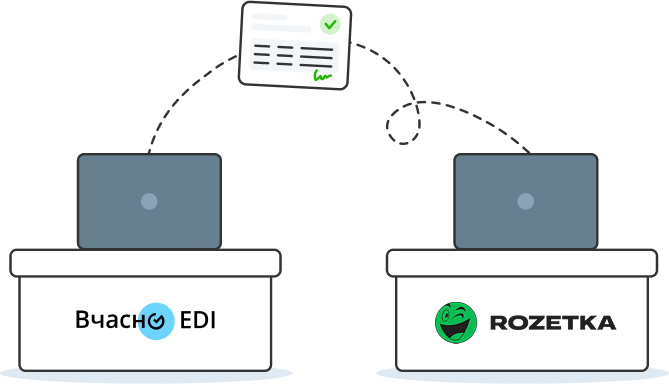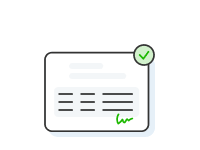Integration with accounting systems is the most effective way to work with EDI services. It is convenient for both retail chains and their suppliers. In this article, we will explain how integration helps suppliers in EDI exchange.
What problems does integration solve for suppliers?
Suppliers with a small number of customers most often process orders in the web interface of the EDI service, as this does not require significant technical or human resources. However, as the scale increases, working in the web interface inevitably leads to time consumption, errors, and other difficulties. This causes losses to the company and damages relationships with partners.
Integration solves these problems. Let’s take a closer look at the benefits of integrated EDI exchange for suppliers.
![]()
Processing large volumes of orders
To process each order in the web cabinet, the manager must log in to the EDI service, create return documents for the order, check and, if necessary, add information if it was not specified at the beginning of work with the network. If there are dozens of orders, this process takes a lot of time. This slows down the shipment of goods.
With integration, the manager can download all orders for a specific customer from the accounting system. This is especially convenient if the customer constantly orders the same list of goods: in such cases, the data verification stage takes a minimum of time.
As the experience of Vchasno.EDI customers shows, through the integrated service, a manager can process 140 orders per day or more.
![]()
Minimizing errors caused by the «human factor»
When working in the web office, the manager has to check the stock levels and manually transfer each item from the order (ORDERS) to the accounting system to create an expense invoice. If the volume of orders is large, this inevitably leads to errors: the manager may specify the wrong quantity of goods, outdated prices, etc. Each such error is a risk of financial losses, penalties from the network, and returns.
EDI exchange through integration with the accounting system allows you to automate data verification. In EDI documents, they are structured: all the information needed by the supplier is displayed in separate fields. When processing an order, the manager can check the stock levels and prices by barcode in their accounting system.
![]()
Working in a single interface
Without integration, employees are forced to work in two different systems simultaneously:
- the accounting system — for internal processes: accounting for balances, generating invoices;
- the EDI provider’s web office — for receiving orders and exchanging data with the network.
This causes delays in work. Managers have to constantly switch between browser windows and their accounting system and copy data manually.
Integration creates a single workspace. Managers work in the familiar interface of their accounting system. All EDI documents are downloaded automatically for further exchange with the retail network.
EDI service integration: typical use cases in retail
Integrating EDI services with your accounting system optimizes the entire supply chain. Let’s take a closer look at how integration simplifies the processes that are most important to suppliers.
📦 Order processing
When working with orders in the web office, the manager must:
- open each order (ORDERS) separately;
- check the data (availability of goods in stock, prices) for each order in the accounting system;
- generate a confirmation (ORDRSP) in the EDI service for each order.
How it works with integration. All new orders automatically appear in the accounting system. The system automatically checks the availability of goods and prices and then generates an order confirmation (ORDRSP). If a particular product is out of stock, the corrected information is automatically transmitted to the retail chain.
🚚 Logistics and shipping
This is the most important stage in the delivery of goods, where mistakes are unacceptable. Inconsistencies in the data on delivery notes can result in the retail chain refusing to accept the goods, and the supplier losing time and money.
In the EDI service, the manager creates a dispatch notification (DESADV) and a delivery note (COMDOC). In the web cabinet, they must:
- transfer data from the order (ORDERS) to the accounting system and generate a delivery note (COMDOC);
- manually fill in the data for the dispatch advice (DESADV) in the EDI service;
- create and sign an electronic delivery note (COMDOC) based on the dispatch advice (DESADV) or order confirmation (ORDRSP).
How it works with integration. With one click, the manager creates a shipping notification (DESADV) and sends it to the network. This allows the network’s warehouse to prepare in advance for receiving the goods.
After that, the manager generates an expense invoice (COMDOC) in the accounting system based on the order (ORDERS). This is a legally significant document, so the manager must additionally sign it with an electronic signature.
The entire chain of documents is created from a single source — the network order. This ensures complete consistency of data in all documents.
🏷️ Managing the product catalog and prices
The manager updates the product catalog in their accounting system. To send it to the network, they must:
- export data from the accounting system to an external file (usually an Excel spreadsheet);
- upload it to the EDI service;
- send it to the retail network as a PRICAT document.
Manual data updates pose risks for the supplier. They may accidentally delete lines when making changes to the catalog or send an outdated version to the customer.
How it works with integration. The supplier can centrally update their product catalog and automatically send it to all connected networks. This ensures that networks always order products at current prices.
Working with EDI through a web office is only a temporary solution for the supplier. Maximum efficiency and resource savings can only be achieved by integrating the EDI service with the accounting system. This is an investment that quickly pays for itself by freeing up employee time and reducing financial losses from errors.
Advantages of integration: experience of Vchasno customers
In Ukrainian retail, integrated EDI exchange has become the standard for cooperation with many retail networks. Chains use many types of documents, and errors in them are unacceptable.

For example, the Rozetka marketplace has transferred the entire chain of documents for ordering goods to EDI. 98% of their suppliers use the Vchasno.EDI service.
The use of integrated EDI services helps suppliers expand their cooperation with retail networks. Thanks to integration, they process orders faster and can quickly adjust exchange parameters if the chain imposes new requirements.
In particular, such results were achieved by Biosfera, a Ukrainian manufacturer and distributor of household goods. The company integrated the Vchasno.EDI service with its accounting system in 2021 to optimize its work with retail networks. Working with the integrated service has helped the company scale its cooperation with networks.
While we initially worked only with Rozetka, electronic document management now covers 23 retail networks. And instead of 50-55 documents in 2021, we are now processing tens of thousands.
How to integrate Vchasno.EDI with your accounting system
Integration does not require significant human and time resources. The supplier’s IT specialists can independently configure integration via API, FTP, or connect the accounting system integration module. If necessary, the supplier can contact Vchasno.EDI specialists.
Suppliers can integrate both individual EDI documents and entire supply chains with the accounting system. Usually, integration setup consists of several stages:
- the supplier company forms a team to conduct testing;
- the team, together with Vchasno.EDI specialists, configures the integration;
- the parties send a test EDI document to the network;
- the supplier checks whether the EDI exchange is working correctly.
The experience of Vchasno customers shows that it is possible to integrate the entire chain of EDI documents with the accounting system within one month.
The integration of EDI services with accounting systems automates the entire supply process from order to shipment. This allows suppliers to reduce operating costs (for printing, personnel, postal services), speed up the entire supply cycle, and generate profits faster. Working in an integrated service enhances the supplier’s reputation and allows them to scale their cooperation with networks.







